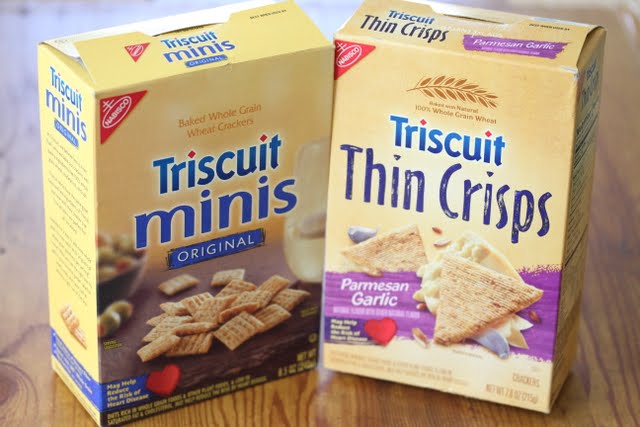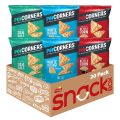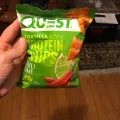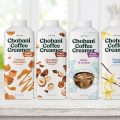Triscuits are a popular brand of snack crackers produced by Nabisco, which is a subsidiary of Mondelez International. Triscuits are made from whole wheat and typically have a woven texture. They are known for their crunchy texture and are often enjoyed plain or with various toppings such as cheese, spreads, or dips.
Triscuits were first introduced in 1902 and have since become a staple in many households. Over the years, Nabisco has expanded the Triscuit line to include different flavors and variations, including reduced-fat options and different seasonings.
The name “Triscuit” is derived from the words “electricity” and “biscuit,” reflecting the original marketing claim that the crackers were baked by electricity. The crackers are made with simple ingredients, primarily whole wheat, vegetable oil, and salt.
Triscuits are commonly found in grocery stores and are a popular choice for snacking or as a base for appetizers. They are often associated with healthier snacking options due to their whole wheat content, although it’s important to note that their nutritional value can vary depending on the specific flavor or variation.
The ingredients of original Triscuits typically include:
- Whole Grain Wheat
- Vegetable Oil (such as soybean or canola oil)
- Salt
These three ingredients are the primary components of Triscuits. However, it’s essential to note that the specific recipe and ingredients may vary slightly depending on the flavor or variation of Triscuits you choose, as different flavors may incorporate additional seasonings or ingredients.
As always, it’s advisable to check the packaging or the specific product’s ingredient list for the most accurate and up-to-date information on the ingredients used in that particular variation of Triscuits.
The general nutritional profile of original Triscuits (per serving size of about 6 crackers, approximately 28 grams):
| Nutrient | Amount per Serving |
| Calories | Around 120 |
| Total Fat | Approximately 3.5g |
| – Saturated Fat | Less than 1g |
| – Trans Fat | 0g |
| Cholesterol | 0mg |
| Sodium | Around 160mg |
| Total Carbohydrates | Approximately 20g |
| – Dietary Fiber | Roughly 3g |
| – Total Sugars | Less than 1g |
| – Added Sugars | 0g |
| Protein | Around 3g |
Please note that these values are general approximations and may vary slightly depending on the specific flavor or variation of Triscuits. It’s always recommended to refer to the nutrition label of the specific Triscuit product you have for the most accurate information.
Are Triscuits Healthy?
Triscuits are often touted as a healthier snacking option due to their whole-grain composition. However, it’s important to examine their nutritional content and consider them within the context of a balanced diet. Let’s delve into the factors that determine whether Triscuits can be considered a healthy snack.
Whole Grain Composition
One of the key aspects that contribute to Triscuits’ reputation as a healthier choice is their whole grain composition. Whole grains contain all parts of the grain, including the bran, germ, and endosperm, providing a good amount of fiber, vitamins, minerals, and phytochemicals. Triscuits are primarily made from whole-grain wheat, which retains the beneficial components of the grain.
Fiber Content
Triscuits can contribute to your daily fiber intake. Fiber is an essential nutrient that aids in digestion, helps maintain a healthy weight, and supports heart health. Triscuits typically provide around 3 grams of dietary fiber per serving. However, it’s worth noting that the fiber content can vary depending on the specific flavor or variation of Triscuits.
Moderate Fat and Sodium Levels
Triscuits have a moderate fat content, with approximately 3.5 grams of total fat per serving. The fat primarily comes from the vegetable oil used in their production. It’s important to note that the fat content includes a small amount of saturated fat, which should be consumed in moderation as part of a balanced diet.
In terms of sodium, Triscuits contain around 160 milligrams per serving. While this is a relatively moderate amount, individuals on low-sodium diets should be mindful of their intake, as it can contribute to daily sodium levels.
Possible Considerations
While Triscuits can be part of a healthy diet, there are a few considerations to keep in mind. First, some Triscuit variations may contain additional ingredients, such as flavorings or seasonings, which can impact the overall nutritional profile. It’s essential to read the product labels to be aware of any added sugars, artificial additives, or potential allergens.
Second, portion control is crucial. It’s easy to consume more than the recommended serving size, which can increase calorie and sodium intake. Being mindful of portion sizes and pairing Triscuits with other nutrient-dense foods like vegetables, fruits, or proteins can help create a well-balanced snack or meal.
Overall Dietary Context
When assessing the healthiness of Triscuits, it’s essential to consider them within the broader context of your overall dietary pattern. While Triscuits can offer whole grains and fiber, relying solely on them as a snack may neglect other essential nutrients that can be obtained from a varied diet. Incorporating a range of whole foods, including fruits, vegetables, lean proteins, and healthy fats, is crucial for a well-rounded and nutritious diet.
It’s always recommended to consult with a registered dietitian or healthcare professional who can provide personalized advice based on your specific dietary needs, preferences, and health goals.
In conclusion, Triscuits can be considered a healthier snacking option due to their whole grain composition, fiber content, and moderate fat and sodium levels. However, it’s important to consume them in moderation, be mindful of portion sizes, and incorporate them as part of a balanced diet that includes a variety of nutrient-rich foods.





